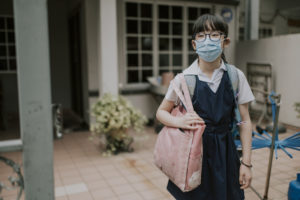February 1, 2021
By Dwight Akerman, OD, MBA, FAAO

Home confinement during the COVID-19 pandemic was associated with a significant myopic shift among Chinese children aged 6 to 8, according to new research published in JAMA Ophthalmology. Because young children are in a critical period for the development of myopia, this population’s refractive status may be more sensitive to environmental changes compared with older individuals.
Led by researchers at Tianjin Medical University, the prospective study used school-based vision screenings in 123,535 children aged 6 to 13 years from 10 elementary schools in Feicheng, China, over six consecutive years, ending in July 2020. They recorded the spherical equivalent refraction for each student and compared their findings and the prevalence of myopia in children during the pandemic versus in the previous five years.
Schools in China were closed from January to May 2020, during which time online learning was offered for one hour a day for students in grades one and two and two and a half hours for those in grades three to six.
Analyses of the research demonstrated:
- A substantial myopic shift (approximately −0.3 D) was found in the 2020 school-based photoscreenings compared with previous years (2015-2019) for children aged 6 (−0.32 D), 7 (−0.28 D), and 8 (−0.29 D) years
- Girls had earlier development of myopia than boys, and the right eye was more myopic than the left eye
- Prevalence of myopia in the 2020 photoscreenings was higher than that seen within 2015-2019 for children aged 6 (21.5 percent vs. 5.7 percent), 7 (26.2 percent vs. 16.2 percent), and 8 (37.2 percent vs. 27.7 percent) years
- Differences in SER and the prevalence of myopia between 2020 and previous years were minimal in children aged 9 to 13 years
The researchers concluded that home confinement during the coronavirus pandemic seemed to be linked to a substantial shift toward myopia in students 6 to 8 years old. Reasons for this, they said, may include less time spent outdoors and more screen time, adding that less outdoor activity is known to be a significant risk factor for an increased incidence of myopia in elementary school children.
Most studies show a significant protective effect of outdoor exposure when children are outside for at least two hours per day. Therefore, I encourage you to educate children and parents that it is vital to be exposed to a minimum of 120 minutes of intermittent outdoor light exposure per day. See “The Great Outdoors,” December 1, 2020, Review of Myopia Management.
Abstract
Jiaxing Wang, MD, PhD; Ying Li, MD, PhD; David C. Musch, PhD, MPH; et al
Importance: Time spent in outdoor activities has decreased owing to home confinement for the COVID-19 pandemic. Concerns have been raised about whether home confinement may have worsened the burden of myopia owing to substantially decreased time spent outdoors and increased screen time at home.
Objective: To investigate the refractive changes and prevalence of myopia in school-aged children during the COVID-19 home confinement.
Design, Setting, and Participants: A prospective cross-sectional study using school-based photoscreenings (non-cycloplegic autorefraction) with the Spot Vision Screener, version 2.1.4 (Welch Allyn) in 123,535 children aged 6 to 13 years from 10 elementary schools in Feicheng, China, was conducted. The study was performed during six consecutive years (2015-2020). Data were analyzed in July 2020.
Exposures: Noncycloplegic autorefraction was examined using a photoscreener device.
Main Outcomes and Measures: The spherical equivalent refraction was recorded for each child, and the prevalence of myopia for each age group during each year was calculated. The mean spherical equivalent refraction and prevalence of myopia were compared between 2020 (after home confinement) and the previous five years for each age group.
Results: Of the 123,535 children included in the study, 64,335 (52.1 percent ) were boys. A total of 194,904 test results (389,808 eyes) were included in the analysis. A substantial myopic shift (approximately −0.30 diopters [D]) was found in the 2020 school-based photoscreenings compared with previous years (2015-2019) for younger children aged 6 (−0.32 D), 7 (−0.28 D), and 8 (−0.29 D) years. The prevalence of myopia in the 2020 photoscreenings was higher than the highest prevalence of myopia within 2015-2019 for children aged 6 (21.5 percent vs. 5.7 percent), 7 (26.2 percent vs. 16.2 percent), and 8 (37.2 percent vs. 27.7 percent) years. The differences in spherical equivalent refraction and the prevalence of myopia between 2020 and previous years were minimal in children aged 9 to 13 years.
Conclusions and Relevance: Home confinement during the COVID-19 pandemic appeared to be associated with a significant myopic shift for children aged 6 to 8 years, according to 2020 school-based photoscreenings. However, numerous limitations warrant caution in the interpretation of these associations, including the use of noncycloplegic refractions and lack of orthokeratology history or ocular biometry data. Younger children’s refractive status may be more sensitive to environmental changes than older ages, given the younger children are in a critical period for the development of myopia.
Wang J, Li Y, Musch DC, et al. Progression of myopia in school-aged children after COVID-19 home confinement. JAMA Ophthalmology. Published online January 14, 2021.
DOI: https://doi.org/10.1001/jamaophthalmol.2020.6239













